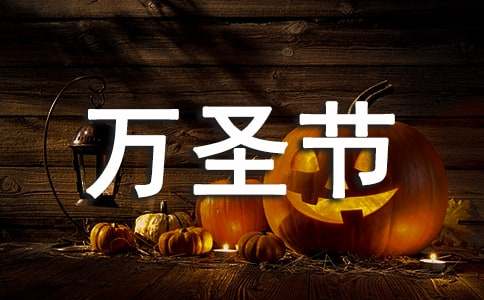萬圣節的由來英文簡介
眾所周知,在西方國家,每年的10月31日為“萬圣節之夜”。萬圣節是西方國家的傳統節日。下面帶來萬圣節的由來英文簡介,希望能幫到你!

Halloween, or Hallowe'en, a holiday celebrated on the night of October 31, is a mix of ancient Celtic practices, Catholic and Roman religious rituals and European folk traditions that blended together over time to create the holiday we know today.
萬圣節前夜(每年10月31日),在其形成過程中逐漸融合了凱爾特習俗、天主教儀式和歐洲民間傳統,最終形成了我們今天所見的這樣一個節日。
Ancient
遠古時期
Shades: Throughout ancient history, Shades meant the spirit of a dead person, residing in the underworld.
幽靈:遠古時期,人們認為幽靈是生活在地下世界的死者的靈魂。
Carving gourds into elaborately decorated lanterns dates back thousands of years to Africa.
將葫蘆精雕細刻、做成燈籠的習俗可追溯到幾千年前的非洲。
800-450 B.C.
公元前800-450年
The ancient Celts believed that wearing masks would ward off evil spirits.
古凱爾特人相信戴上面具可以避開邪靈。
Pre-1st Century
1世紀前
Samhain: The Festival of Samhain is a celebration of the end of the Gaelic harvest season.
死神節:蓋爾人(蘇格蘭和愛爾蘭的凱爾特人)慶祝豐收季節結束的節日。
1st Century
1世紀
Gaels believed that the border between this world and the otherworld became thin on Sambain; because animals and plants were dying, it allowed the dead to reach back through the veil that separated them from the living.
蓋爾人相信,在死神節,現世與冥界的邊界會逐漸消失。動物和植物紛紛死去,而死者將穿過把他們同生者隔開的幕布重回世間。
Bonfires played a major role in the Festival of Samhain. Celebrants wore costumes, mostly skins and animal heads, and danced around bonfires.
篝火對于死神節來說是必不可少的。參加慶典的人們穿上動物的皮毛和頭顱做成的服裝,圍著篝火舞蹈。
By A.D. 43, Romans had conquered much of Celtic territory. Two Roman festivals were combined with the Celtic celebration of Samhain: Feralia, a day in late October when Romans commemorated the passing of the dead, and a day to honor Pomona, Roman goddess of fruit and trees.
公元43年,羅馬人占領了凱爾特人的大部分領土,并將兩個羅馬節日與死神節的`傳統結合起來:一個是紀念死者的Feralia節(十月末的一天),另一個是紀念羅馬的果樹女神Pomona的節日。
Werewolf: The original werewolf of classical mythology, Lycaon, a king of Arcadia who, according to Ovid's Metamorphoses, was turned into a ravenous wolf by Zeus. Possibly the source of the term lycanthropy.
狼人:古羅馬詩人奧維德在他的《變形記》中描繪了古典神話中狼人的原型——阿卡迪亞王呂卡翁,由于觸怒天神宙斯而被變成了一匹狼。也許“變狼妄想狂”一詞就是來源于這個故事。
3rd Century
3世紀
In the Roman Catholic church, a commemoration of "All Martyrs" was celebrated between mid April and early May.
在每年四月中旬到五月初這段時間,羅馬天主教會慶祝一個名為“眾殉道者節”的紀念性節日。
7th Century
7世紀
The festival of All Siants dates to May 13 in 609 or 610, when Pope Boniface IVconsecrated the Pantheon at Rome.
公元609或610年,教皇卜尼法斯四世為羅馬萬神殿祝圣,并將5月13日定為“眾圣人節”。
This date was an ancient pagan observation, the end of the Feast of the Lemures, in which the evil and restless spirits of all the dead were appeased.
這一節期原本是古老的異教節日——勒姆瑞斯(夜游魂)節的末尾,在這一節日期間人們試圖安撫那些邪惡且永不安寧的亡魂。
8th Century
8世紀
Pope Gregory III designated November 1st All Saints' Day, a time to honor saints and martyrs.
教皇格列高利三世將每年11月1日定為“眾圣人節”,以此紀念圣人和殉道者。
Many believe the pope was attempting to replace the Celtic festival of the dead with a related, but church-sanctioned holiday.
人們相信,教皇此舉是為了用一個教會認可的節日來替代凱爾特的亡者之節日。
Saint Boniface declared that belief in the existence of witches was un-Christian.
圣卜尼法斯(680-754,本篤會修士,美因茨大主教)宣布,相信女巫的存在是不合基督教教義的。
10th Century
10世紀
The Catholic church made November 2nd All Souls' Day, a day to honor the dead.
天主教會將每年11月2日定為“萬靈節”,以紀念死者。
The three Catholic celebrations, the eve of All Saints', All Saints', and All Souls', were called Hallowmas.
至此,天主教的三大節日——眾圣人節前夜,眾圣人節,萬靈節,被統稱為“Hallowmas”(即“萬圣節”之意)。
Middle Ages
中世紀
Carved turnips in Ireland and Scotland are used as candle lanterns in windows to ward off harmful spirits.
在愛爾蘭和蘇格蘭,人們將蕪菁(形似蘿卜)雕刻成燈籠放在窗臺上,以此抵擋邪靈。
Soul cakes, often simply referred to as souls, were given out to soulers (mainly consisting of children and the poor) who would go from door to door on Hallowmas singing and saying prayers for the dead. Each cake eaten would represent a soul being freed from Purgatory.
另一項傳統習俗涉及“靈魂餅”:在萬圣節期間,小孩和窮人會挨家挨戶地唱歌并為死者祈禱,人們則給他們一種被稱作“靈魂餅”的點心作為報酬。據說每吃掉一個“靈魂餅”,就會有一個靈魂被從煉獄中拯救出來。
【萬圣節的由來英文簡介】相關文章:
感恩節的由來簡介英文10-02
清明節的由來英文簡介04-30
感恩節由來英文簡介10-02
感恩節的由來簡介英文介紹10-02
萬圣節的英文簡介09-25
萬圣節簡介英文09-25
萬圣節英文簡介09-25
感恩節的由來簡介英文版10-02
萬圣節背景英文簡介09-25
萬圣節英文簡介課件09-24